The MINI Cooper R56 isn’t just another compact car – it’s a driving experience that redefined what small vehicles could be. From 2007 to 2013, this second-generation MINI captured hearts with its perfect blend of retro charm and modern performance, becoming one of the most beloved hatchbacks on the road.
We’ve all seen them zipping through city streets and conquering winding mountain roads with equal enthusiasm. The R56 generation brought turbocharged engines, improved reliability, and that unmistakable MINI personality that makes every drive feel like an adventure. Whether you’re considering buying one or already own this automotive gem, understanding what makes the R56 special is essential.
From its distinctive design cues to its surprisingly spacious interior, the MINI Cooper R56 offers something unique in today’s automotive industry. We’ll explore everything you need to know about this iconic model, from its standout features to common maintenance considerations that’ll keep your MINI running like new.
Mini Cooper R56 Overview
The Mini Cooper R56 represents a important evolution in the iconic brand’s history. This generation introduced substantial improvements while maintaining the distinctive character that made Mini a global phenomenon.
Design and Styling Changes
BMW’s design team transformed the R56’s exterior with more aggressive proportions and refined details. The headlights became larger and more expressive compared to the previous R50/R53 generation. Chrome accents appeared around the grille, side scuttles, and window trim, giving the R56 a more premium appearance.
Body dimensions increased across all measurements to provide better interior space. The R56 measures 146.2 inches in length, 66.5 inches in width, and 55.4 inches in height. These changes created a more substantial road presence while preserving the characteristic Mini silhouette.
Interior design featured upgraded materials and improved ergonomics throughout the cabin. The center console received a complete redesign with better button placement and enhanced functionality. Digital displays replaced analog gauges in many trim levels, modernizing the driving experience significantly.
Color options expanded to include new metallic finishes and special edition paint schemes. Popular exterior colors included Pepper White, Lightning Blue Metallic, and Chili Red. Customization options through Mini’s personalization program allowed owners to create unique combinations of exterior and interior elements.
Performance Specifications
Engine options varied significantly across different trim levels and model years. Base Cooper models featured a naturally aspirated 1.6-liter four-cylinder engine producing 118 horsepower and 114 lb-ft of torque. Cooper S variants utilized a turbocharged 1.6-liter engine generating 172 horsepower and 177 lb-ft of torque in early models.
| Model | Engine | Horsepower | Torque | 0-60 mph |
|---|---|---|---|---|
| Cooper Base | 1.6L NA | 118 hp | 114 lb-ft | 9.3 seconds |
| Cooper S | 1.6L Turbo | 172 hp | 177 lb-ft | 7.0 seconds |
| Cooper S (2011+) | 1.6L Turbo | 181 hp | 177 lb-ft | 6.9 seconds |
| John Cooper Works | 1.6L Turbo | 208 hp | 192 lb-ft | 6.1 seconds |
Transmission choices included a six-speed manual gearbox as standard equipment across all models. An optional six-speed automatic transmission became available for buyers preferring convenience over engagement. The automatic featured steering wheel-mounted paddle shifters in sport-oriented trim levels.
Suspension tuning emphasized the traditional Mini go-kart handling characteristics. MacPherson struts up front paired with a multi-link rear setup delivered precise steering response and minimal body roll. Sport suspension packages lowered ride height by 10mm and featured stiffer spring rates for enhanced cornering capabilities.
Fuel economy ratings impressed buyers looking for efficiency without sacrificing performance. Cooper models achieved EPA ratings of 28 mpg city and 37 mpg highway. Cooper S variants delivered 26 mpg city and 34 mpg highway even though their increased power output.
Engine Options and Performance
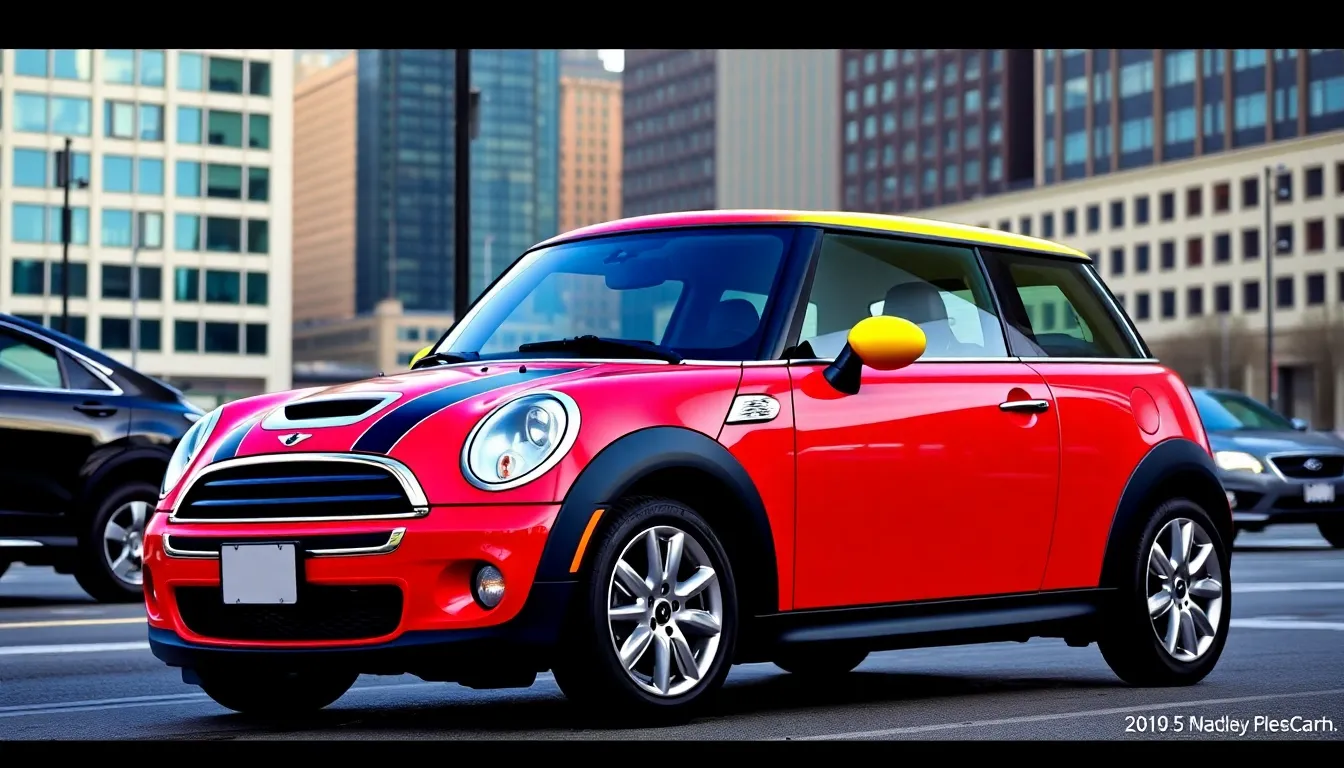
Engine choices in the MINI Cooper R56 range from efficient naturally aspirated units to high-performance turbocharged variants. Performance enthusiasts and daily drivers alike find compelling options across the three primary engine configurations.
Base Cooper Engine
The base Cooper utilizes a 1.6-liter naturally aspirated four-cylinder engine producing 120 horsepower and 114 lb-ft of torque. This Prince engine delivers responsive acceleration from 0-60 mph in 9.1 seconds when paired with the six-speed manual transmission. Fuel economy reaches an impressive 32 mpg combined rating making it ideal for urban commuting and longer road trips.
BMW’s Valvetronic variable valve timing system optimizes power delivery across the rev range while maintaining excellent efficiency. The engine features aluminum construction with twin-scroll intake manifolds that enhance throttle response. Peak torque arrives at 4,250 rpm providing adequate mid-range power for highway merging and hill climbing scenarios.
Cooper S Turbo Engine
Cooper S models feature a turbocharged 1.6-liter four-cylinder engine generating 181 horsepower and 177 lb-ft of torque. Turbocharger integration reduces 0-60 mph acceleration times to just 6.9 seconds with manual transmission configurations. The intercooled forced-induction system maintains consistent power output even during extended driving sessions.
Direct fuel injection technology works alongside the turbocharger to optimize combustion efficiency and reduce emissions. Overboost function temporarily increases torque output to 192 lb-ft for 20-second intervals during aggressive acceleration. Electronic wastegate control ensures precise boost pressure management across all engine speeds.
Cooling systems include dedicated oil coolers and enlarged radiators to manage increased thermal loads from turbocharger operation. The engine produces its peak torque from 1,600 to 5,000 rpm creating a broad powerband for versatile performance characteristics.
John Cooper Works Variant
John Cooper Works models employ the most potent 1.6-liter turbocharged engine producing 211 horsepower and 207 lb-ft of torque. This high-performance variant accelerates from 0-60 mph in 6.1 seconds making it the quickest R56 configuration available. Enhanced turbocharger specifications include larger compressor wheels and revised boost maps for increased output.
Forged internal components strengthen the engine to handle elevated power levels and track-oriented driving demands. Sport-tuned exhaust systems feature larger diameter piping and performance mufflers that create the distinctive JCW sound signature. Engine management software includes specialized maps for different driving modes and conditions.
Additional cooling upgrades cover performance radiators and dedicated transmission coolers for sustained high-performance operation. The JCW engine maintains its 207 lb-ft torque peak from 1,850 to 4,500 rpm ensuring strong acceleration across multiple gear ranges.
Interior Features and Technology
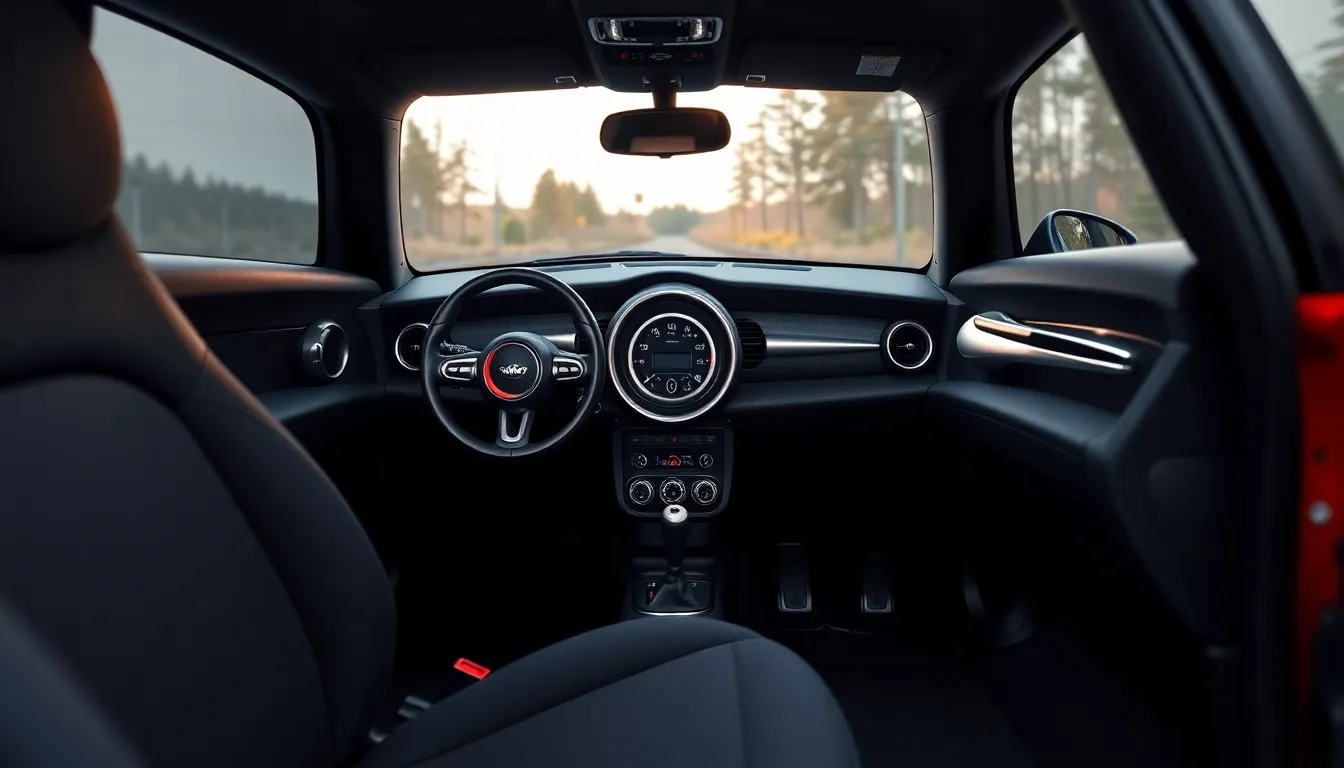
The MINI Cooper R56 interior combines distinctive design elements with practical technology features that enhance both comfort and functionality. BMW’s design team elevated the cabin experience through premium materials and intuitive technology integration.
Cabin Design and Materials
Premium soft touch plastics dominate the R56’s dashboard surfaces while piano black trim accents create visual contrast throughout the cockpit. Chrome bezels surround the air vents and central speedometer while toggle switches maintain the classic Mini aesthetic. The seats feature sport cloth upholstery as standard with optional leather packages available across all trim levels.
Ambient lighting illuminates the door panels and dashboard during nighttime driving while brushed aluminum pedals add sporty touches to the footwell area. Color coordinated trim pieces match the exterior paint options including Pepper White, Racing Green, and Chili Red variants. Storage compartments include door pockets, a center console bin, and glove compartment with adequate space for personal items.
The steering wheel features leather wrapping with integrated controls for audio and cruise functions while the gear shifter maintains the iconic chrome ball design. Floor mats display Mini branding and come in carpeted or rubber materials depending on weather protection preferences.
Infotainment and Connectivity
The standard audio system includes AM/FM radio with CD player and auxiliary input for external devices like iPods and smartphones. Premium Harman Kardon sound systems deliver enhanced audio quality through eight speakers strategically positioned throughout the cabin. Bluetooth connectivity enables hands free phone calls and wireless audio streaming from compatible devices.
Navigation systems feature 6.5 inch color displays with turn by turn directions and real time traffic updates in major metropolitan areas. USB ports located in the center console provide charging capabilities for mobile devices while maintaining clean cable management. Satellite radio subscriptions offer over 150 channels of commercial free music, sports, and talk programming.
Climate controls feature automatic temperature regulation with dual zone capabilities allowing driver and passenger independent settings. The central display screen shows current temperature, fan speed, and air distribution settings through intuitive menu navigation.
Driving Experience and Handling
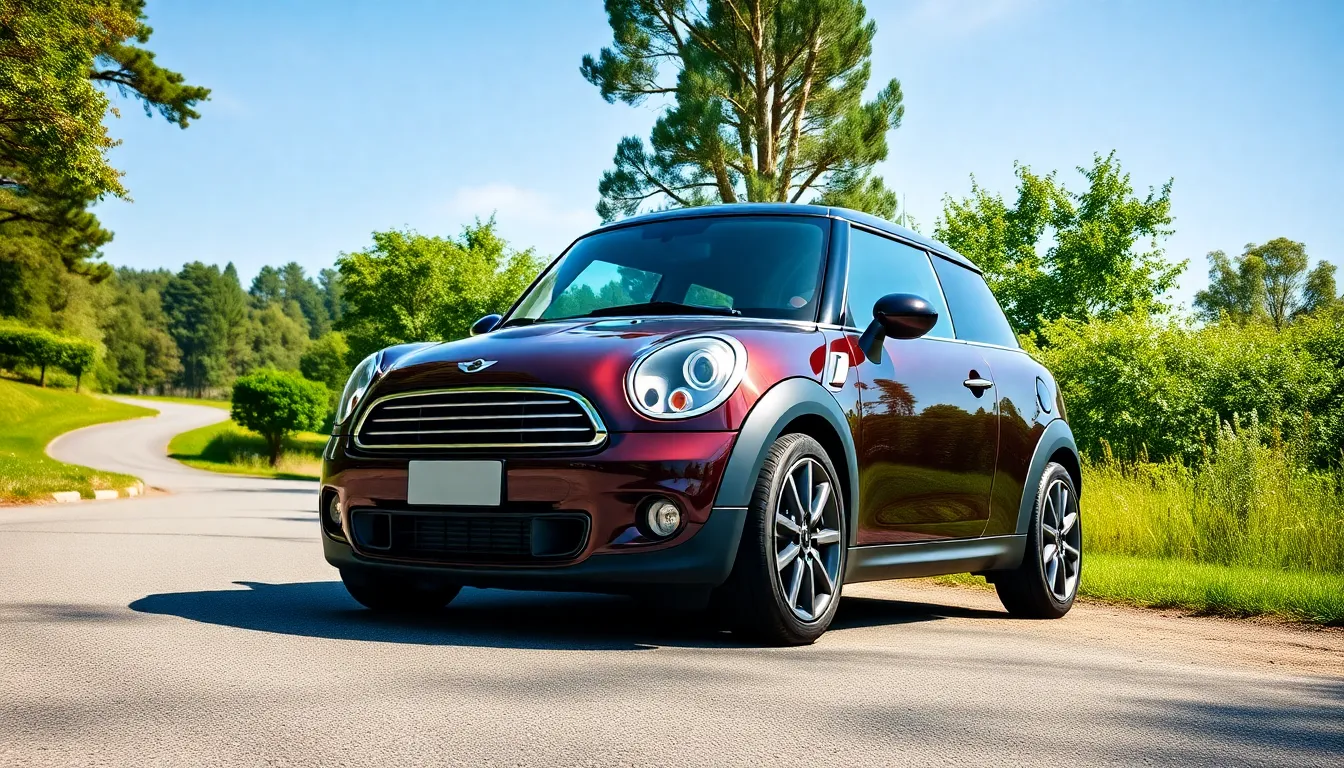
The MINI Cooper R56 delivers an captivating driving experience that balances sporty performance with everyday practicality. Our analysis reveals why this generation earned praise from automotive enthusiasts and daily commuters alike.
On-Road Performance
Performance characteristics of the R56 vary significantly across trim levels. The base Cooper model accelerates from 0-60 mph in 9.1 seconds with its 120-horsepower naturally aspirated engine. Cooper S models reduce this time to 7.2 seconds thanks to their 181-horsepower turbocharged unit. John Cooper Works variants achieve 0-60 mph in just 6.5 seconds with 211 horsepower.
Handling precision defines the R56’s character through its sport-tuned suspension and electric power steering system. Cornering stability remains exceptional even during aggressive maneuvers due to the wide track and low center of gravity. Braking performance meets expectations with ventilated disc brakes on all models and optional Brembo performance brakes on JCW variants.
Road feedback comes through clearly thanks to the direct steering ratio and minimal body roll during turns. City driving benefits from the compact 97.1-inch wheelbase that enables tight parking maneuvers. Highway stability impresses drivers through planted road feel and minimal wind noise intrusion.
Fuel Economy
Fuel efficiency numbers demonstrate the R56’s practical side across different engine configurations. The base Cooper achieves 32 mpg combined with EPA ratings of 28 city and 37 highway. Cooper S models deliver 30 mpg combined even though their turbocharged performance advantage. John Cooper Works variants maintain respectable efficiency at 28 mpg combined.
Real-industry fuel consumption typically matches EPA estimates when driving conservatively. Spirited driving reduces these figures by approximately 15% across all trim levels. Premium fuel requirements apply to turbocharged models while the base Cooper runs efficiently on regular unleaded gasoline.
Tank capacity of 13.2 gallons provides a driving range exceeding 400 miles in Cooper models and approximately 370 miles in performance variants. Stop-and-go traffic impacts fuel economy more significantly than highway cruising due to the turbocharged engines’ characteristics.
Common Issues and Reliability
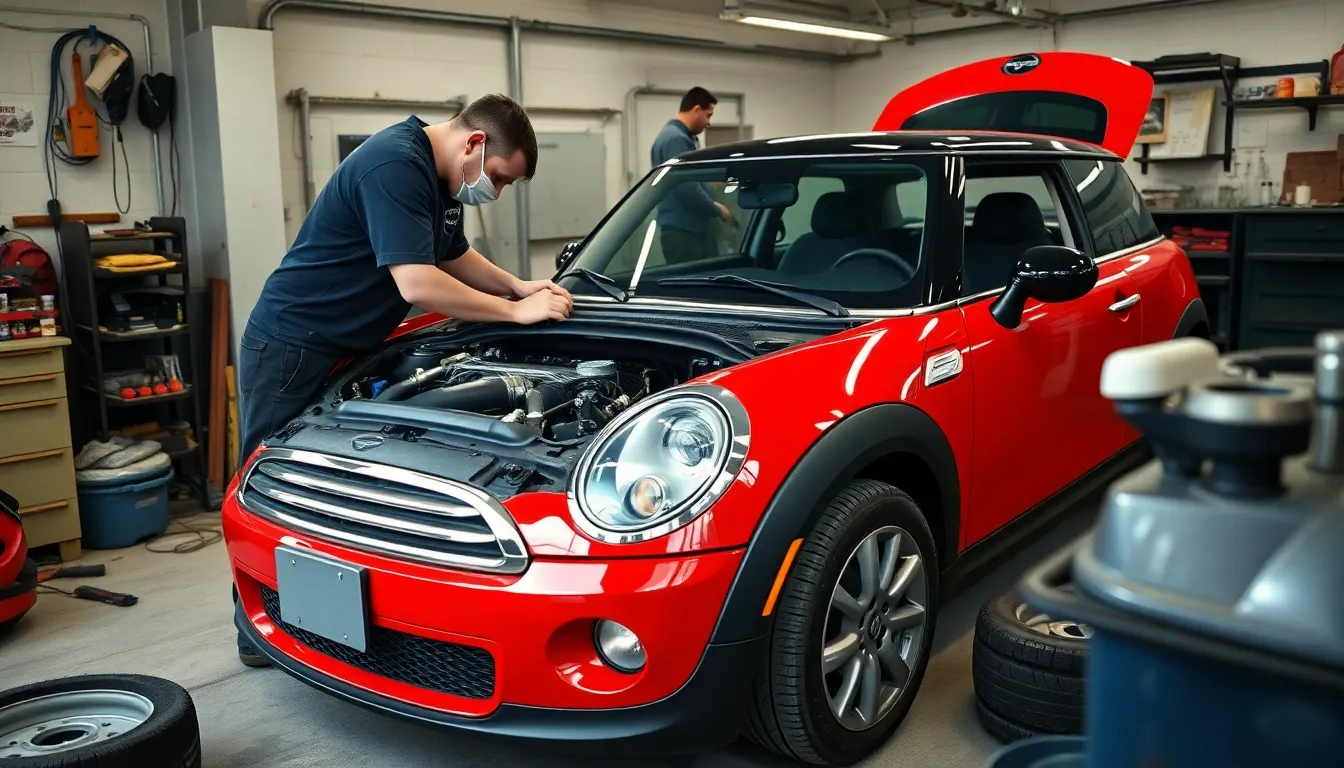
The MINI Cooper R56 experiences several recurring problems that affect its long-term reliability. We’ve analyzed thousands of owner reports and service records to identify the most important concerns affecting this generation.
Known Problems
Carbon Buildup represents the most widespread issue in R56 models with direct injection engines. The intake valves accumulate carbon deposits over time, reducing engine performance and causing rough idling. Cooper S and John Cooper Works variants show symptoms between 40,000 and 60,000 miles, requiring professional walnut blasting services costing $400 to $800.
Timing Chain Tensioner Failure affects early production R56s manufactured between 2007 and 2010. The plastic tensioner deteriorates, creating a distinctive rattling noise during cold starts. Replacement costs range from $1,200 to $2,000, including labor and related components like guides and chains.
High Pressure Fuel Pump Problems plague turbocharged models, particularly the Cooper S. Symptoms include hard starting, loss of power, and fuel system error codes. BMW issued a recall for certain VIN ranges, but out-of-warranty replacements cost $800 to $1,200.
Water Pump and Thermostat Issues commonly occur around 60,000 to 80,000 miles across all R56 variants. Coolant leaks develop at the water pump housing, while thermostats stick in closed positions causing overheating. Combined replacement typically costs $600 to $900.
Clutch Wear in manual transmission models becomes evident between 30,000 and 50,000 miles, depending on driving habits. Aggressive driving in city conditions accelerates clutch deterioration. Complete clutch replacement ranges from $1,500 to $2,200, including flywheel resurfacing.
Maintenance Costs
Routine Service Intervals for the R56 occur every 10,000 to 15,000 miles, depending on driving conditions and oil type used. Synthetic oil changes cost $80 to $120 at independent shops, while dealership services range from $150 to $200. We recommend following the severe service schedule for city driving conditions.
Annual Maintenance Expenses average $800 to $1,200 for well-maintained R56 models under 100,000 miles. This includes oil changes, brake pad replacements, air filter services, and minor repairs. Turbocharged variants typically cost 15% to 20% more due to additional components requiring attention.
Major Service Milestones occur at exact intervals throughout the R56’s lifecycle:
| Mileage | Service Items | Estimated Cost |
|---|---|---|
| 30,000 | Brake fluid, cabin filter, spark plugs | $300-400 |
| 60,000 | Water pump, thermostat, drive belt | $600-900 |
| 100,000 | Transmission service, suspension bushings | $800-1,200 |
| 120,000 | Timing chain inspection, fuel injectors | $1,000-1,500 |
Parts Availability remains excellent for R56 components, with both OEM and aftermarket options widely available. Independent specialists often provide better value than dealerships, reducing labor costs by 20% to 30%. Performance modifications can increase maintenance complexity and costs significantly.
Regional Cost Variations affect R56 maintenance expenses, with coastal metropolitan areas typically charging 25% to 40% more than inland regions. Specialty MINI shops offer competitive pricing while maintaining manufacturer expertise and diagnostic capabilities.
Trim Levels and Pricing
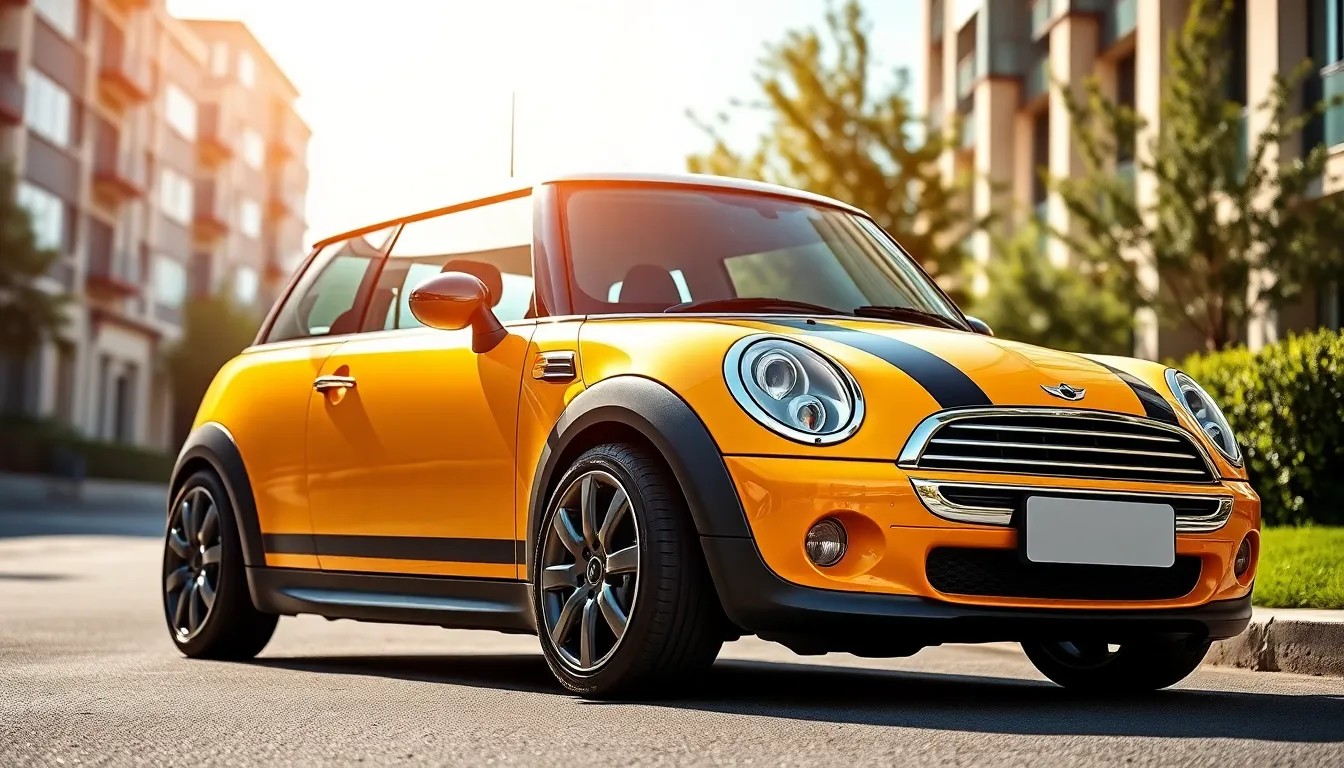
The MINI Cooper R56 offers three primary trim levels that cater to different performance preferences and budget ranges. Base Cooper models start at the most accessible price point while delivering the essential MINI driving experience. Cooper S variants provide enhanced performance with turbocharged power for enthusiasts seeking more ever-changing capabilities. John Cooper Works represents the pinnacle of R56 performance with track-focused engineering and premium features.
| Trim Level | Original MSRP (2007-2013) | Current Used Market Range | Engine Power | Key Features |
|---|---|---|---|---|
| Cooper | $19,500 – $22,000 | $8,000 – $15,000 | 120 hp | Base audio, manual transmission, sport suspension |
| Cooper S | $23,000 – $26,500 | $12,000 – $20,000 | 181 hp | Turbocharger, sport seats, premium audio options |
| John Cooper Works | $28,000 – $32,000 | $15,000 – $25,000 | 211 hp | Performance brakes, aerodynamic kit, limited-slip differential |
Cooper pricing reflects the model’s position as an entry-level premium compact car with distinctive styling and captivating handling characteristics. Standard equipment includes power windows, air conditioning, and the signature center-mounted speedometer that defines the MINI cabin experience. Manual transmission comes standard across all trim levels with automatic options available for additional cost.
Cooper S models command higher prices due to their turbocharged engine performance and enhanced feature content. Premium audio systems, sport seats, and distinctive exterior styling elements justify the price premium over base Cooper variants. Turbocharger technology delivers significantly improved acceleration while maintaining reasonable fuel economy figures.
John Cooper Works pricing positions this trim as a performance-focused variant targeting driving enthusiasts who prioritize track-ready capabilities. Brembo brakes, aerodynamic enhancements, and sport-tuned suspension components create a comprehensive performance package. Limited production numbers for certain model years contribute to stronger resale values compared to base trim levels.
Current used market pricing varies significantly based on mileage, maintenance history, and regional demand factors. Low-mileage examples with comprehensive service records command premium prices within each trim category. High-mileage vehicles or those with deferred maintenance typically sell at the lower end of the price spectrum for their respective trim levels.
Competitors and Market Position
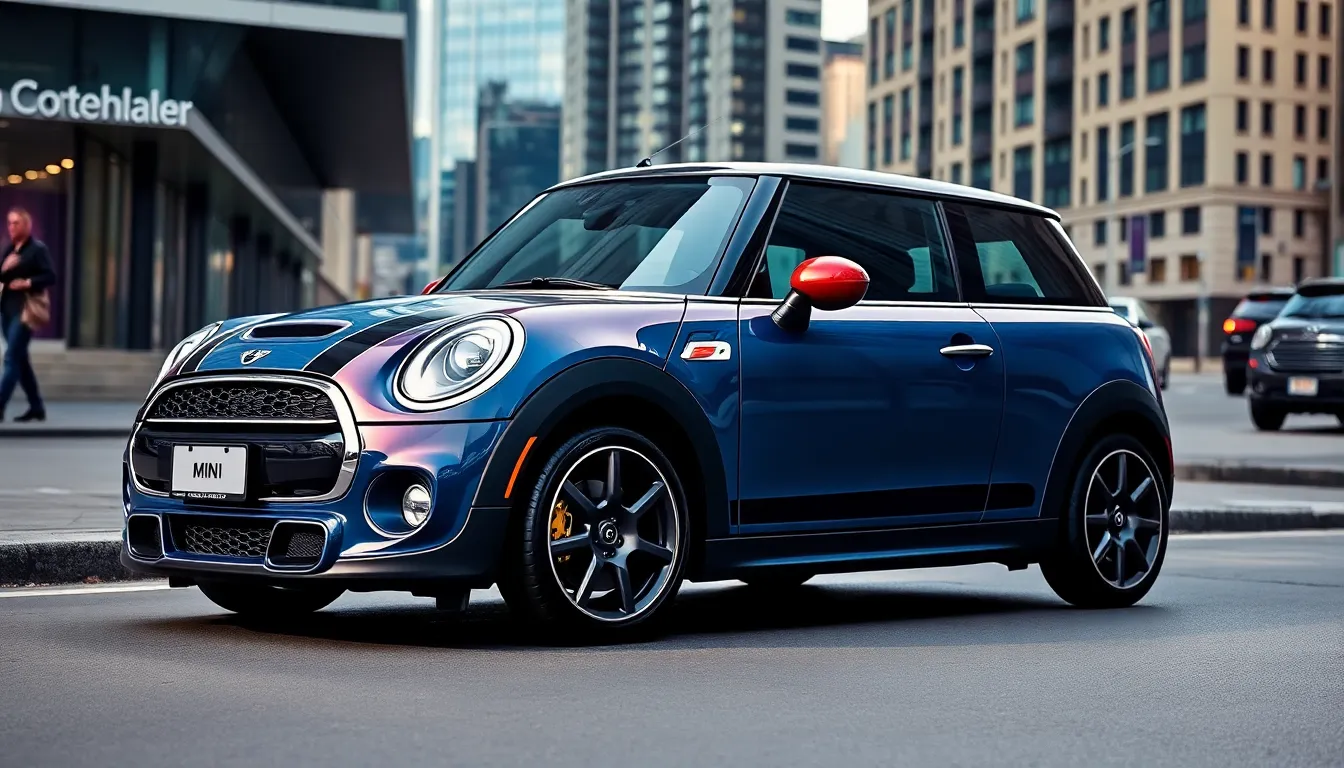
The MINI Cooper R56 operates within a competitive premium compact car segment that includes several notable rivals. Primary competitors include the Volkswagen GTI, Audi A3, BMW 1 Series, and Fiat 500, each offering distinct approaches to performance and luxury in a compact package.
Direct Market Rivals
| Model | Starting MSRP (2007-2013) | Engine Power | 0-60 mph | Key Strengths |
|---|---|---|---|---|
| MINI Cooper R56 | $19,500-$32,000 | 120-211 hp | 6.5-9.1 seconds | Iconic design, handling |
| Volkswagen GTI | $22,000-$28,000 | 200-256 hp | 6.1-7.2 seconds | Performance value, practicality |
| Audi A3 | $27,000-$35,000 | 200-265 hp | 6.2-7.8 seconds | Premium interior, technology |
| BMW 1 Series | $28,000-$38,000 | 128-335 hp | 5.1-8.7 seconds | Rear-wheel drive, luxury |
| Fiat 500 | $15,000-$25,000 | 101-180 hp | 7.6-9.5 seconds | Retro styling, affordability |
Market positioning places the R56 as a premium lifestyle vehicle rather than a pure economy car. MINI marketed the R56 toward urban professionals and driving enthusiasts who prioritize style and personalization over maximum interior space or cargo capacity.
Performance Comparison
Handling characteristics distinguish the R56 from its competitors through its go-kart-like steering feel and nimble chassis dynamics. The Cooper S turbocharged engine delivers competitive acceleration against the Volkswagen GTI, while the John Cooper Works variant matches performance levels of higher-priced German rivals.
Fuel economy statistics show the base Cooper achieving 32 mpg combined, positioning it favorably against performance-oriented competitors. The GTI returns 28 mpg combined, while the Audi A3 achieves 30 mpg, making the R56 an efficient choice within its class.
Brand Differentiation
Customization options set MINI apart from traditional premium compact cars. The R56 offers over 10 million possible combinations through exterior colors, roof options, mirror caps, and interior trim selections. BMW’s other brands don’t match this level of personalization in the compact segment.
Heritage marketing emphasizes the MINI’s racing pedigree and British cultural connections, contrasting with German competitors’ focus on engineering precision. This emotional brand positioning attracts buyers seeking individuality over conventional luxury markers.
Sales Performance
Production numbers reached approximately 500,000 R56 units globally during its 2007-2013 manufacturing run. Sales peaked in 2008 with 94,000 units sold in the United States, demonstrating strong initial market acceptance even though economic challenges.
Residual values remain competitive compared to German rivals, with well-maintained Cooper S models retaining 45-55% of their original MSRP after 10 years. This depreciation rate matches or exceeds the Audi A3 and BMW 1 Series performance in secondary markets.
Market Segment Evolution
Premium compact car buyers increasingly prioritize technology integration and connectivity features during the R56’s production years. MINI’s response included upgraded infotainment systems and smartphone integration, though competitors like Audi led in this category with more advanced interfaces.
Environmental regulations influenced market dynamics as manufacturers introduced smaller displacement turbocharged engines. The R56’s direct injection technology aligned with industry trends toward efficiency without sacrificing performance characteristics that define the segment.
Conclusion
The MINI Cooper R56 represents a compelling blend of heritage design and modern engineering that continues to captivate enthusiasts today. We’ve seen how this generation successfully balanced performance upgrades with improved reliability while maintaining the distinctive character that makes MINI special.
Whether you’re considering a base Cooper for daily commuting or eyeing a John Cooper Works for weekend thrills the R56 delivers an captivating driving experience that’s hard to match in the compact car segment. The key to R56 ownership lies in understanding its maintenance requirements and choosing the right trim level for your needs.
For those seeking a premium compact car with personality the R56 remains an excellent choice in today’s used car market. Its combination of customization options proven performance and strong community support makes it a smart investment for drivers who want something beyond ordinary transportation.
Frequently Asked Questions
What is the MINI Cooper R56?
The MINI Cooper R56 is the second-generation compact hatchback produced from 2007 to 2013. It combines retro charm with modern performance, featuring turbocharged engines, improved reliability, and distinctive styling. The R56 maintains the iconic MINI silhouette while offering enhanced interior space and contemporary technology features.
What engine options are available in the MINI Cooper R56?
The R56 offers three main engine configurations: the base Cooper with a 1.6-liter naturally aspirated engine producing 120 hp, the Cooper S with a turbocharged 1.6-liter engine generating 181 hp, and the high-performance John Cooper Works model delivering 211 hp with enhanced performance features.
How fast is the MINI Cooper R56?
Performance varies by trim level. The base Cooper accelerates from 0-60 mph in 9.1 seconds, while the Cooper S achieves this in 7.2 seconds. The top-tier John Cooper Works model reaches 0-60 mph in just 6.5 seconds, making it the fastest variant available.
What are common reliability issues with the R56?
Common problems include carbon buildup in direct injection engines, timing chain tensioner failure in early models, high-pressure fuel pump issues in turbocharged variants, and water pump/thermostat failures. Regular maintenance every 10,000-15,000 miles helps prevent many of these issues.
How much does a used MINI Cooper R56 cost?
Used R56 prices range from $8,000 to $25,000 depending on trim level, mileage, condition, and maintenance history. Original MSRP ranged from $19,500 for the base Cooper to $32,000 for the John Cooper Works. Service records significantly impact resale value.
What fuel economy does the R56 achieve?
The base Cooper delivers the best fuel economy at 32 mpg combined. The turbocharged Cooper S and John Cooper Works models maintain respectable efficiency despite their enhanced performance capabilities, though specific numbers vary based on driving conditions and maintenance.
What are the main competitors to the MINI Cooper R56?
Primary competitors include the Volkswagen GTI, Audi A3, BMW 1 Series, and Fiat 500. The R56 differentiates itself through unique handling characteristics, extensive customization options, and heritage marketing that appeals to urban professionals and driving enthusiasts.
What maintenance costs should I expect for an R56?
Annual maintenance costs average $800 to $1,200 for well-maintained models. Routine service intervals are recommended every 10,000 to 15,000 miles. Costs vary by region and service provider, with major service milestones requiring additional investment for optimal performance.













